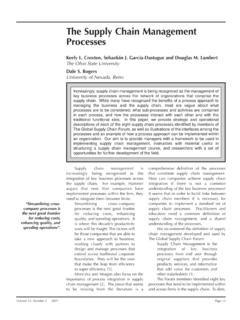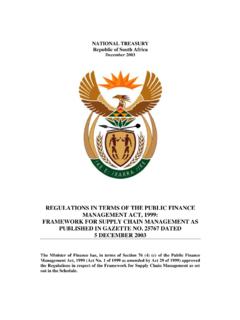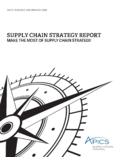Transcription of The Supply Chain Management Processes
1 Volume 12, Number 22001 Page 13 Supply Chain Management isincreasingly being recognized as theintegration of key business Processes acrossthe Supply Chain . For example, Hammerargues that now that companies haveimplemented Processes within the firm, theyneed to integrate them between firms: Streamlining cross-companyprocesses is the next great frontierfor reducing costs, enhancingquality, and speeding operations. Itis where this decade s productivitywars will be fought. The victors willbe those companies that are able totake a new approach to business,working closely with partners todesign and manage Processes thatextend across traditional corporateboundaries.
2 They will be the onesthat make the leap from efficiencyto super efficiency [1]. Monczka and Morgan also focus on theimportance of process integration in supplychain Management [2]. The piece that seemsto be missing from the literature is acomprehensive definition of the processesthat constitute Supply Chain can companies achieve Supply chainintegration if there is not a commonunderstanding of the key business Processes ?It seems that in order to build links betweensupply Chain members it is necessary forcompanies to implement a standard set ofsupply Chain Processes . Practitioners andeducators need a common definition ofsupply Chain Management , and a sharedunderstanding of the Processes .
3 We recommend the definition of supplychain Management developed and used byThe Global Supply Chain Forum: Supply Chain Management is theintegration of key businessprocesses from end user throughoriginal suppliers that providesproducts, services, and informationthat add value for customers andother stakeholders [3].The Forum members identified eight keyprocesses that need to be implemented withinand across firms in the Supply Chain . To date,The Supply Chain ManagementProcessesKeely L. Croxton, Sebasti n J. Garc a-Dastugue and Douglas M. LambertThe Ohio State UniversityDale S. RogersUniversity of Nevada, RenoIncreasingly, Supply Chain Management is being recognized as the Management ofkey business Processes across the network of organizations that comprise thesupply Chain .
4 While many have recognized the benefits of a process approach tomanaging the business and the Supply Chain , most are vague about whatprocesses are to be considered, what sub- Processes and activities are containedin each process, and how the Processes interact with each other and with thetraditional functional silos. In this paper, we provide strategic and operationaldescriptions of each of the eight Supply Chain Processes identified by members ofThe Global Supply Chain Forum, as well as illustrations of the interfaces among theprocesses and an example of how a process approach can be implemented withinan organization. Our aim is to provide managers with a framework to be used inimplementing Supply Chain Management , instructors with material useful instructuring a Supply Chain Management course, and researchers with a set ofopportunities for further development of the field.
5 Streamlining cross-company Processes isthe next great frontierfor reducing costs,enhancing quality, andspeeding operations .Page 14 The International Journal of Logistics Managementthe published descriptions of these processeswere limited to one-paragraph summariesthat provide little guidance on how toimplement a process approach [4]. Ourpurpose in this paper is to provide more detailon the sub- Processes and activities thatcomprise the Supply Chain Processes . Thegoal is to provide Management withguidelines to help with implementation,instructors with material for structuring asupply Chain Management course andresearchers with a detailed framework forfuture research on Supply Chain Management .
6 The paper is organized as follows. First,there is a brief review of the Supply chainframework. Next, there is a section on each ofthe eight Processes . This is followed by a sectionon implementation. Finally, opportunities forfuture research and conclusions are presented. Supply Chain ManagementThe Global Supply Chain Forumidentified eight key Processes that make upthe core of Supply Chain Management [5]: Customer Relationship Management Customer Service Management Demand Management Order Fulfillment Manufacturing Flow Management Procurement Product Development and Commercialization term procurement is a source ofconfusion. Novak and Simco highlight theconfusion by citing studies in whichprocurement is defined as.
7 The act all those activities necessary toacquire goods and services consistent withuser requirements [6]. Other authors usesimilar definitions [7]. Because thesedefinitions do not adequately represent ourview of the Supply Chain process, we haverenamed the procurement process supplierrelationship Management . Also, for furtherclarification we have changed the name ofthe returns process to returns eight key business Processes run thelength of the Supply Chain and cut acrossfirms and functional silos within each firm(see Figure 1). Functional silos includeMarketing, Research and Development,Finance, Production, Purchasing andLogistics.
8 Activities in these Processes resideinside a functional silo, but an entire processwill not be contained within one function. Figure 1 Supply Chain Management :Integrating and Managing Business Processes Across the Supply ChainCUSTOMER RELATIONSHIP MANAGEMENTCUSTOMER SERVICE MANAGEMENTDEMAND MANAGEMENTORDER FULFILLMENTMANUFACTURING FLOW MANAGEMENTSUPPLIER RELATIONSHIP MANAGEMENTPRODUCT DEVELOPMENT AND COMMERCIALIZATIONRETURNS MANAGEMENTI nformation FlowTier 2 SupplierSupply Chain Business ProcessesTier 1 SupplierManufacturerCustomerLogisticsPRO DUCTION FLOWR & DProductionPurchasingFinanceMarketingCon sumer/End-userSource: Adapted from Douglas M. Lambert, Martha C. Cooper, and Janus D. Pagh, Supply Chain Management : ImplementationIssues and Research Opportunities, The International Journal of Logistics Management ,Vol.
9 9, No. 2 (1998), p. purpose in thispaper is to provide moredetail on the sub- Processes and activitiesthat comprise the supplychain 12, Number 22001 Page 15 While Management of all firms in each Supply Chain should consider these eight Processes , the relative importance of each process and the specific activities included may vary. The sub- Processes and activities we describe are designed from the perspective of a manufacturing company sitting near the middle of the Supply Chain (see Figure 1).Each process is described at strategic and operational levels. The strategic portion consists of the establishment and strategic Management of each process,and provides a blueprint for is a necessary first step in integrating the firm with other members of the Supply Chain .
10 The operational portion is theactualization of the process once it has been , we will describe the sub-processesand activities that make up each of the eightprocesses as well as the interactions betweenprocesses, functions, and key members of thesupply Chain . The description of each processis accompanied by a figure that illustrates thesub- Processes and the interfaces between Relationship ManagementThe customer relationship managementprocess provides the structure for how therelationship with the customer is developedand maintained. Management identifies keycustomers and customer groups to be targetedas part of the firm s business mission [8].Customer teams tailor Product and ServiceAgreements (PSA) to meet the needs of keyaccounts and segments of other customers [9].




